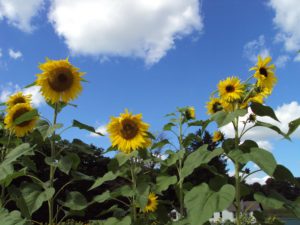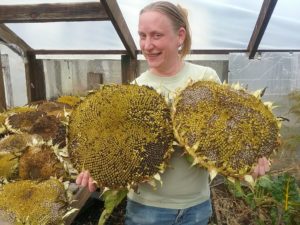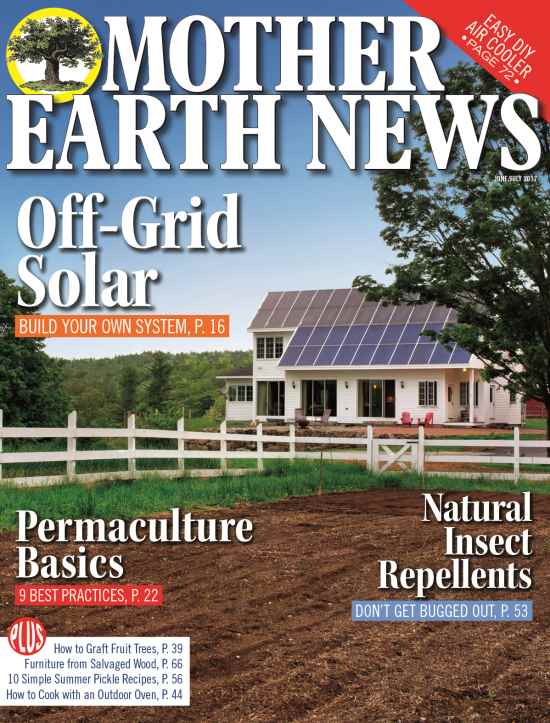We plant rows of sunflowers every year here in the gardens at Pleasant Valley Farm. These beautiful flowers provide a surprising number of benefits!
Our garden field is roadside, next to our farm stand. Each spring it’s exciting to see tidy rows of vegetable plants. But as the season progresses, it seems each year the weeds get ahead of us to some extent. It’s usually about the time when the garden is at peak production, when picking and preserving take up a significant portion of each week. It’s about this time that the sunflowers start to bloom. Long lines of cheerful yellow, their faces following the track of the sun each day. It definitely draws the eye upward and away from the not-so-tidy garden. I’m a firm believer that an attractive-looking farm increases on-farm sales, and this is a very low maintenance way to add color and beauty at a time I’m always very busy.

Sunflowers add eye-catching beauty to the garden.
Pollinators and other wildlife love sunflower seeds. The late summer blooms give bees a food source after other garden crops are starting to wear out. After the nectar fades, the sunflower heads will produce abundant amounts of seed that is beloved by a variety of wildlife. Songbirds often cling to the heads and harvest the seeds. The ones they spill are carried off by squirrels, chipmunks, and other small animals. Many of my farm stand customers enjoy feeding birds and squirrels, so I cut some sunflower seed heads and offer them for sale. Our farm stand stays open through the end of November, so it’s nice to have season-extending crops that ripen after the first frost to keep the tables full.
Planting sunflowers can also provide a natural trellis for other crops in the garden. Rather than putting up pea trellis, I can grow runner beans and other climbing crops underneath the sunflowers. Scarlet runner beans look stunning on a trellis of tall sunflowers! It save the labor and time of putting up the trellis and then tearing it down at the end of the season. The stalks are simply plowed under in the spring, adding organic matter to our garden soil.
Perhaps the most important reason we grow sunflowers is as extra feed for our flock over the winter. I harvest the sunflower when the petals disappear and the heads nod down towards the soil. I do this by cutting the heads off with pruning shears and laying them in a single layer on the slatted benches in my seed starting greenhouse. This space would sit otherwise sit empty all winter, but turned out to be an ideal way to store the seeds. I also cut smaller heads and put them in 50-lb mesh cabbage sacks. These are filled about halfway and hung from the greenhouse’s wooden rafters for maximum air circulation. In the winter months, when forage is non-existent and the ground is covered in snow, I’ll break these heads into pieces and give them to the poultry. I’ll also save seed from some of the most productive, colorful heads to plant in the spring. This reduces my seed cost in the spring and allows me to plant as many sunflowers as I have room for in the field.

We had a great sunflower harvest this year!
Feeding sunflower seeds to my chickens, ducks, turkeys, and peafowl has a number of benefits. It gives them a more enriched environment with simulated foraging. Sunflower seeds are not the main part of their diet as they still get free-choice mash. Still, it cuts down on our cost of feed over the winter months, when less money is coming in. The vitamins and protein in sunflower seeds are beneficial as well. They will actually help my hens lay more eggs earlier in the spring. This is crucial for my spring business, as I incubate and hatch heritage breed poultry and offer it for sale. I also offer fertile hatching eggs and eating eggs when I have more than I can fit in my incubator. Feed supplements are typically expensive, but I can eliminate that cost by growing my own, and the increase in egg production increases what I’m able to sell at a time of year the income is greatly needed.
Sunflower seeds can also be a delicious and nutritious snack for humans. Seeds can be seasoned and roasted. Seeds and petals have been used medicinally as diuretics and expectorants and to treat coughs and kidney inflammation.
Sunflowers have a great number of potential uses around a homestead or small farm. We make room for them each year. If you haven’t grown them yet, you may want to consider dedicating some space to them when you’re making plans for next spring!











1 Comment
I used to be recommended this web site by my cousin. I’m no longer positive whether or not this put
up is written via him as nobody else understand such unique
about my trouble. You’re incredible! Thank you!